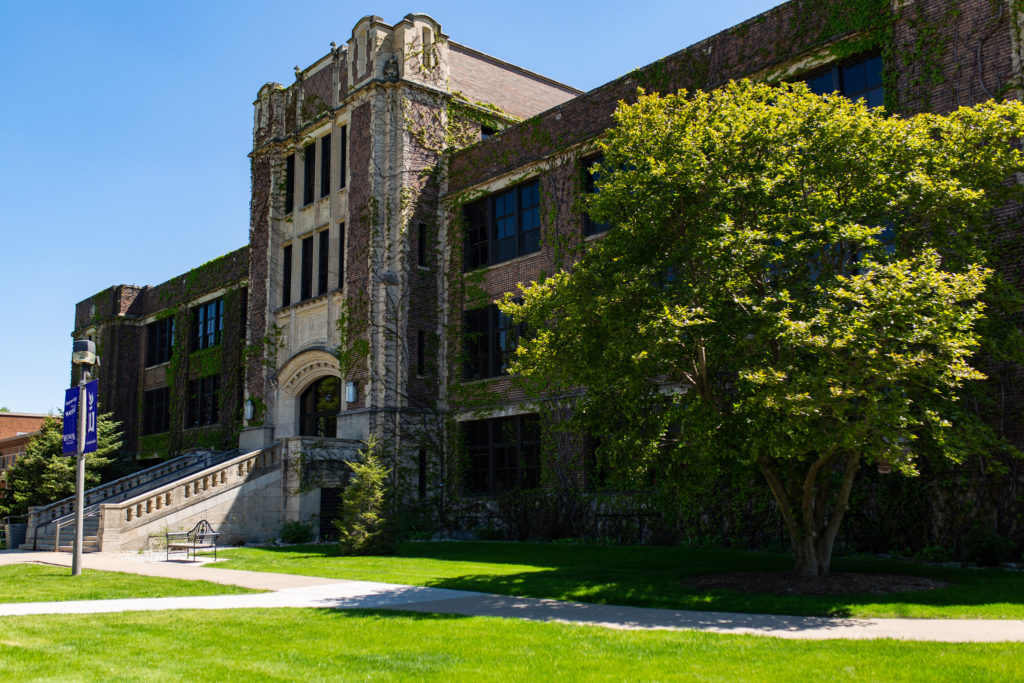 Winona State University is committed to creating an inclusive campus environment.
Winona State University is committed to creating an inclusive campus environment.
As part of the university’s efforts to become more conscious of implicit bias, it will install removable panels to cover the 1930s era mural in the front entrance of Somsen Hall. The mural, which spans three walls, was the result of a Work Progress Administration program during the Depression. It was painted by Minnesota native and teacher John Martin Socha, who reportedly studied under famed Mexican muralist Diego Rivera.
It’s said that Socha often based his work on interviews with pioneers, allowing the firsthand accounts to shape his view on historical events in the region. This approach resulted in a historically biased depiction of white settlers arriving in Winona.
The first wall shows the legend of Wenonah, the Indian “princess” for whom the city of Winona was historically named. On the second wall is a depiction of Winona’s early settlers carving through the wilderness and forming a new community. The third wall shows the frontiersmen and Indigenous People, including a tribal chief and riverboat captain, coming together in “peace.”
Absent from the mural is any historical depiction of the atrocities suffered by the Indigenous People. The Dakota Tribe, among others, had their land forcibly taken from them, ultimately leading to the Dakota War of 1862 and the mass hanging of the “Dakota 38+2.”
“The mural fails to acknowledge the suffering, genocide, and mass-execution inflicted upon the Dakota and other Indigenous People of the region,” shares Aaron Camacho, an Indigenous advocate on the Dakota Winona Council and 2018 graduate of WSU. “It also fails to acknowledge human beings as equals and original caretakers of the land stolen from them.”
As the university is situated on the ancestral lands of the Dakota People, WSU leaders routinely work with and seek counsel from the Oceti Ŝakowiŋ to ensure proper acknowledgment, honor and respect is shown for the Dakota Nations and the sacred land of all Indigenous People. It was through this partnership that a recommendation emerged to take action in addressing the prominent mural located in the campus’s main administrative building.
According to Roger Boulay, Assistant Professor of Art and Design, “WSU has received consistent feedback from Indigenous members of our community over the past decades that the mural’s portrayal of their People is historically inaccurate and deeply hurtful to them. WSU is on Dakota land; therefore, we are choosing to refrain from colonizing depictions of the Dakota on land taken from their People.”
While the public will no longer encounter the mural upon entrance to the building, the artwork will be preserved for educational purposes. The coverings being installed are removable in nature, which will allow for continued discussion and learning opportunities surrounding equity and bias.
“I am not only pleased with the outcome we have arrived at,” says WSU Associate Vice President for Equity and Inclusive Excellence Jonathan Locust, “but the process leading to this outcome.”
Camacho expressed her gratitude as well, “Wopila tanka, many thanks to the relatives who have given their time, heart and patience to bring our community of learners to this point.”
The project is scheduled to be completed by the end of August 2020.
About Winona State University
Founded in 1858, Winona State University is a comprehensive, regional public university with over 7,600 students on campuses in Winona and Rochester. Around half of WSU students are first-generation, meaning neither parent has a four-year bachelor’s degree. The oldest member of the Minnesota State system, WSU offers more than 80 undergraduate, pre-professional, licensure, graduate and doctorate programs in five colleges: Business, Education, Liberal Arts, Nursing & Health Sciences, and Science & Engineering.
Winona State is ranked as the second public institution in Minnesota by U.S. News & World Report’s “Best Colleges,” has been named among the “Best in the Midwest” by The Princeton Review for 16 years in a row, and has been featured as one of America’s 100 Best College Buys for quality and value for 24 consecutive years. The University generates $447.9 million in economic impact for the region per year. The University’s mission is to enhance the intellectual, social, cultural and economic vitality of the people and communities we serve: a community of learners improving our world. For more information, visit winona.edu.
